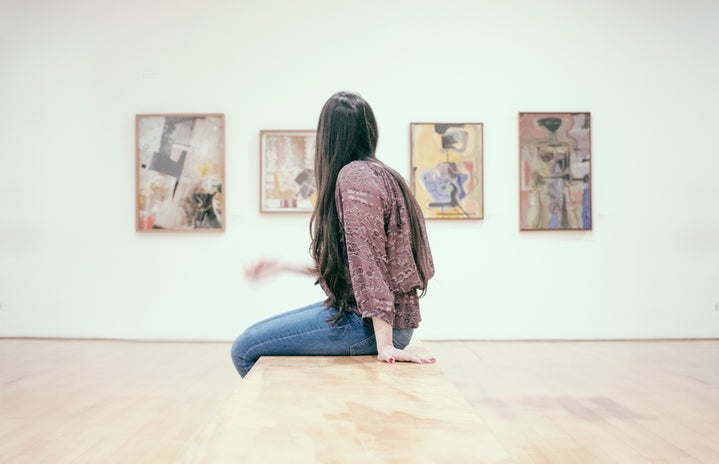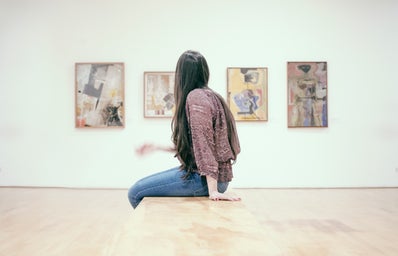My work-life balance is non-existent. I take on more things than I can handle and sometimes setting aside time for myself is difficult. However, with the small amount of time I did have, I spent it at the Dalí and I really enjoyed it. Currently, they have a new temporary exhibit called The Shape of Dreams and I took my time to appreciate the museum’s artworks in its theme.
I was looking forward to visiting the museum as I walked to the front entrance. However, I was a little annoyed I could not take my backpack-purse with me, but I understand the security measures for the museum. I locked my locker and wore my wristband before heading upstairs.
I felt a little tired before the museum’s visit. I only had a short window before I had to go to my workshop. I needed a small distraction from my routine. I just needed an escape for a little while before I started.
The Shape of Dreams exhibit has a constant theme of how dreams can be contextualized and how they are made. These dreams can be constructed from religion, the supernatural, or from abstract, cerebral interpretations. This exhibit had a repeated trend of portraying how dreams can be illogical and can have various interpretations. Many different artists were displayed across the room with varying styles and tones attributed to each piece. One of the most common traits was Greek interpretations of surrealist dreams through Greek myths. The most common tale was of the Greek goddess of the moon, Diana or Selene, depending on the interpretation, and Endymion.
Greek Myths
In the painting of Diana and Endymion by Jean-Honoré Fragonard, it portrays the myth of Diana, the goddess of the moon, who fell in love with a shepherd that worshiped her. Diana wished for him to have eternal youth and sleep forever. In one of the pieces, it is described that Endymion seems to long for Selene, however, in the myth, Endymion mostly fell asleep watching her within the skies unknowingly to Selene’s affection. These pieces seem to be an attempt to make their love less one-sided for the goddess.
In this myth, Selene is painted as a whimsical being that only appears in the night, further exemplifying the dream-like state Endymion is in and how the painting of Diana and Endymion by Jean-Honoré Fragonard shows how her desire to be with him can be considered a vision. It was serene and magical with her ethereal appearance floating towards his sleeping body. I felt as if I was sitting outside gazing at the moon from my porch. A calm and comforting aura that could be slightly ghoulish as she approaches him. Many of the paintings fit with this vivid imagery of a calmly lit night or the very bright aspiration of the day, further separating the boundary between Selene and Endymion. Endymion and Selene can never truly be together as an unobtainable dream. The other painting, Selene and Endymion by Nicolas Poussin, depicted the daytime and further supports that in reality, their love is only a fantasy. This theme of the thought of unobtainable dreams appears in another Greek myth, specifically of Odysseus and Penelope by Johann Heinrich Wilhelm Tischbein.
The painting had a dull yet hopeful feeling as she is talking with her beloved husband. I felt hesitant, yet longing through the distance between Penlope and Odysseus. In the Odyssey, Penelope feels that her aspiration for her husband to return home from his long voyage is only a dream. Odysseus had been gone for over a decade and barely returned home after Poseidon prevented him from moving forward. Penelope remained faithful to him and in the painting, she discusses her hopes and dreams with a stranger. The stranger is the disguised Odysseus who has returned home to reclaim his kingdom. As she describes her unobtainable dream, she tells this stranger her desire to be with her husband. In this scene, it captures the moment where he reveals his identity to his wife by describing how he sculpted the bed frame. This signals that he is the true Odysseus. In the epic, only Odysseus and his wife knew how he constructed their bed frame by hand. This touching moment becomes bittersweet as she cries that she could obtain her unobtainable dream of reuniting with her husband.
Biblical Stories
During my visit, one of the curators pointed me in the direction of a painting called Dog Barking at the Moon by Joan Miro. The painting mostly made me confused, trippy, yet nonchalant. I had a sudden urge to climb the ladder myself yet felt like someone was looking at me from the dog barking in the distance. From their interpretation, it symbolizes the dream of Jacob going up the ladder and towards heaven. The ladder represents the gateway to heaven and the dreams of what heaven resembles the link between God and his children. The ladder to heaven symbolizes the desire in order to achieve going to heaven in the prophecies, however, the dog barking at the moon could possibly be representing Jacob. The barking could symbolize his internal turmoil or humanity’s desire to be with their heavenly father. In the exhibit, there was a physical ladder and a star projection to emphasize the surrealist aspects within the painting. However, I could not find a dog within the exhibit, which could possibly support my theory of the dog symbolizing his humanity or his internal turmoil of desiring to go to Heaven. Either that, or they forgot to place it. Or I am just dumb. Probably the dumb part.
Surrealism
One of my favorite paintings in the exhibit was Frida Kahlo’s Tunas(Still Life with Prickly Pear Fruit) (1938) There were three pears that were placed on a plate that showed that they were slowly decaying. There is a ripe fruit, a slowly decaying fruit, and a fruit that is bloody and crusted. It looks like a heart that is barely beating. The painting has an underlying tone that things do not appear as they seem. The heart-like pear is graphic and probably hints that there is a dark reality within our dreams. I think this painting was her expressing how toxic and unhealthy her relationship with her husband was. She originally loved her husband, but through years of their marriage; she grew to despise him for his cheating nature. A time of realization of the tumultuous relationship she had with him before divorcing him. A time when on the outside she looked beautiful, while internally she was in agony most of her adult life. I liked how unnerved I felt as the shift from beauty to decay cascaded in the painting.
I truly appreciated how it showed the sense of the unsettling reality her life was in and how it appeared pristine in others. It is one reason why I like Frida Kahlo’s works. Her graphic and surrealist art pieces capture her internal strife. She in her short life continued to persevere despite everyone’s expectations and through every personal tragedy, she continued to live. Despite her disability, her home life, and her relationship, she expressed herself truthfully how suffocating and painful her life was. Her simple painting of rotten fruit hinted to her failing relationship to the man she loved.
Although there are many different types of art pieces within the exhibit, there are plenty of Salvador Dalí’s artwork within the exhibit. Many of them show beings that have translucent skin to show that they exist in an illusion of a dream. One of the art pieces of Salvador Dalí’s artwork that caught my attention was Apparatus and Hand. I felt happy within the chaos and curious about all of the objects thrown in and wobbling within the painting. Within the piece, a slab of sand exists as an island away from the distant shoreline. There, an abstract form of a wobbling and towering figure is present. This contraption was completely new and modern, it does not fit in the world that existed. It is like an upside-down pyramid held between two small legs, almost as if it is barely trying to stand still. There are also people on the ground looking up in shock at the figure. There are also parts of a horse that remain translucent or become parts of mountains over the sea line. Floating torsos and beings grasping and praying in the wind to create a chaotic yet peaceful atmosphere.
Although there are many other paintings in the exhibit, my favorite part of the exhibit was the Dalí and DALL·E collaboration.
Dalí and DALL·E
The Dalí and DALL·E collaboration for the dream tapestry was a clever way to end the exhibit. Within the exhibit, a maximum of six people are allowed into the dim room surrounded by six screens with a QR code and the museumgoer can type their description of what dream they would want to see in the tapestry. Whether it be a desire, dream, daydream or previous dreams they had the night before, the visitor can select the AI program to bring their fantasy to life.
Personally, I have not had many interesting dreams lately. Instead, I chose a scene I wanted to see breathed to life. My description of my dream was “a prince of ice haunted by the jolly ghost of his past surrounded by small fairies in a forest.” I had no real expectations of what this painting could look like. Now visualizing it, I truly love it. It was a beautiful and impressionistic take, depicting the fading faces of the ghost children and the ice prince himself. The distance between him and the lonely forest emphasizes his loneliness, fear, and peace. It focuses more on the emotions of the piece through the barren snow. The contorted faces also add to the haunted effect. Seeing the rest of the paintings gave me inspiration. It is amazing all of this was created with an AI program. Some of the scenes were tender, fantastical, and peaceful, all having a more surrealist approach to what a dream would look like.
I love the painting and this interactive experience allowed me to create it. I still have it saved on my phone. You can look at the painting itself within the DALL·E screen and framed screen. All dreams created using the DALL·E collaboration are uploaded onto the website, including the original descriptions, for all to enjoy and appreciate. This interactive exhibit was an ingenious way to create art that was more personal to the visitors and entice them to return to the museum later. The display, in my opinion, truly captures the museum’s ability to share people’s dreams from a span of centuries of artists. It further creates different perspectives throughout the centuries to view dreams as we see them or through the surrealist nature of dreams.
I loved the flow of the exhibit. Each flow had a certain specific subtheme surrounding dreams, but it also can be easily maneuvered from place to place. The paintings can be seen in any order, and it added to the fluidity of dream interpretations in the room. The turbulent paintings of surrealism, the Biblical allusions, and the peaceful depictions of Greek myths. I was enthralled by the words and references to dreams on the floor as I stepped into the exhibit. The desires of myth, the differences of reality and dreams, and the visualization of our dreams made the exhibit feel more cohesive.
The Shape of Dreams exhibit will last until April 30, 2023, located in the Dalí Museum. It is a great exhibit with many pieces to pique your interest. For USFSP students, there is no entry fee, however, there is a reduced price for all students across campuses. It is a great way to explore and share the experience with those around you. I hope you all can share your dream paintings and further delve into what makes these paintings so special to you.

